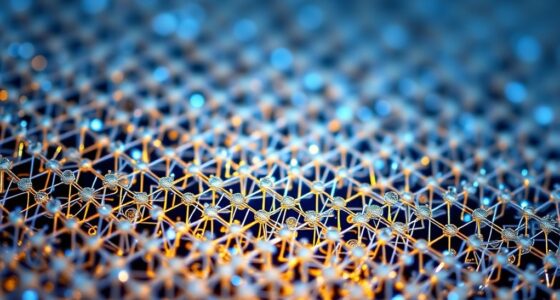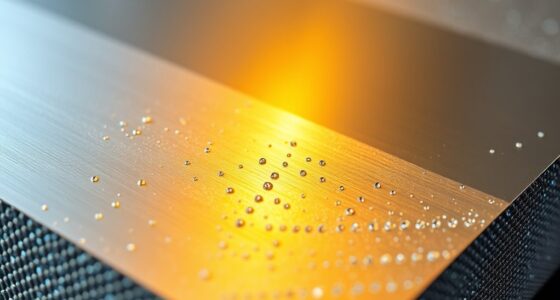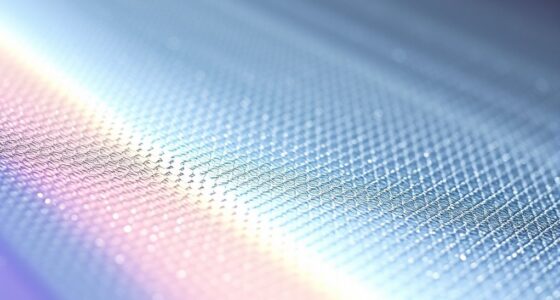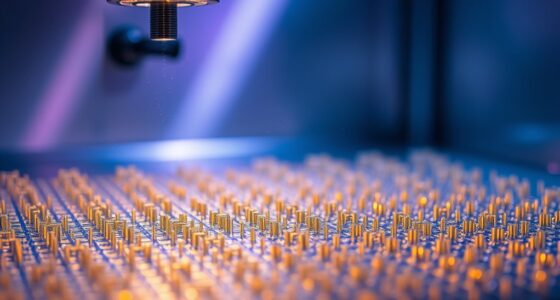Nanoparticle-based thermal conductive adhesives use tiny particles like metals, ceramics, or carbon materials to improve heat transfer in electronic devices. They offer faster, more efficient cooling, reduce weight, and enhance reliability while lowering material costs. These adhesives are formulated with special techniques to guarantee even dispersion and high performance. As industry demands grow, ongoing research is refining these materials for better sustainability and application. Exploring further reveals how these innovations can transform thermal management solutions.
Key Takeaways
- Nanoparticle-based thermal conductive adhesives enhance heat transfer between electronic components and heat sinks.
- They utilize metal, ceramic, or carbon nanomaterials to improve thermal conductivity and mechanical stability.
- Optimization involves controlling nanoparticle loading, dispersion, and surface modification for maximum thermal performance.
- Manufacturing techniques like ultrasonication and high-shear mixing ensure uniform nanoparticle dispersion.
- These adhesives support miniaturization and efficient thermal management in electronic devices and industrial applications.
Overview of Thermal Conductive Adhesives
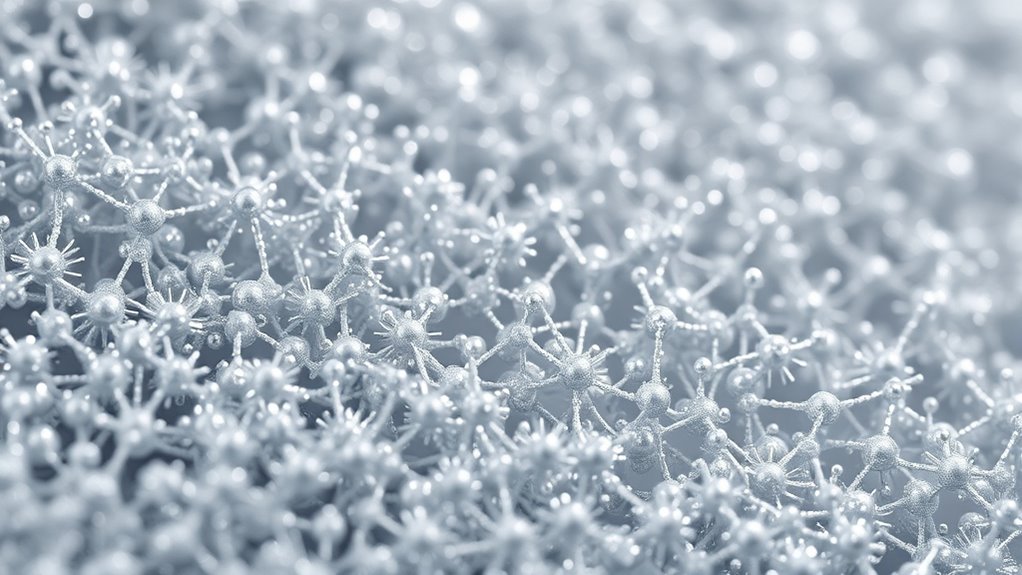
Thermal conductive adhesives are specialized materials designed to efficiently transfer heat between electronic components and their heat sinks or other cooling solutions. Their historical evolution reflects advancements in material science, shifting from simple epoxies to sophisticated formulations that incorporate nanoparticles. Over time, market trends reveal increasing demand for higher thermal conductivity and reliability, driven by miniaturization and higher power densities in electronics. Modern adhesives now combine superior thermal performance with ease of application, making them essential in electronics manufacturing. The market continues to grow as industries seek more effective thermal management solutions, pushing innovations that improve adhesion, thermal conductivity, and environmental stability. As research into nanoparticle integration continues, these adhesives are expected to achieve even greater performance levels, further supporting the trend toward miniaturized and high-performance electronic devices. Understanding this evolution helps you appreciate how these adhesives meet the evolving needs of electronic device cooling.
Types of Nanoparticles Used in Conductive Adhesives
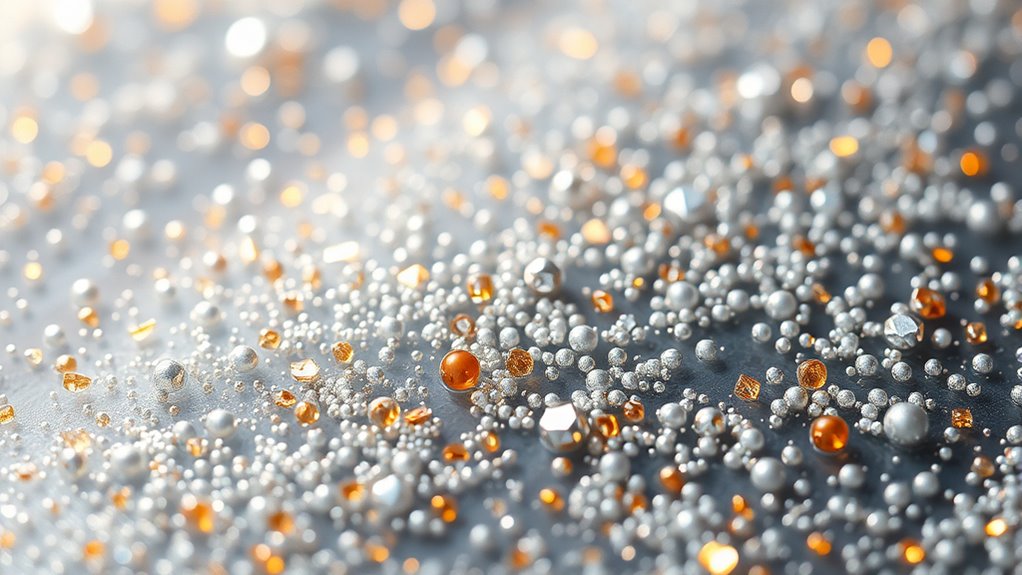
You’ll find that metal nanoparticles offer excellent conductivity, making them popular choices for thermal adhesives. Ceramic and oxide variants provide stability and insulation, while carbon-based nanomaterials bring lightweight, versatile options with unique properties. Understanding these types helps you select the best nanoparticle for your specific application. Additionally, the high thermal conductivity of certain nanoparticles enhances heat dissipation efficiency in electronic devices.
Metal Nanoparticles’ Conductivity
Metal nanoparticles are essential for achieving high electrical and thermal conductivity in adhesive materials, making them a popular choice in electronic applications. Their small size and high surface area facilitate efficient metal conductivity, which improves heat dissipation and electrical performance. When incorporated into adhesives, these nanoparticles promote nanoparticle percolation, forming continuous conductive pathways at lower loadings. This percolation threshold is critical, as it determines the adhesive’s ability to conduct heat and electricity effectively. Silver and copper nanoparticles are common due to their excellent conductivity, but their dispersion and stability are crucial for optimal performance. By carefully controlling nanoparticle distribution, you can enhance the adhesive’s overall conductivity, ensuring reliable connections and efficient heat transfer in electronic devices.
Ceramic and Oxide Variants
Ceramic and oxide nanoparticles have gained popularity as alternatives to metal-based variants in conductive adhesives due to their stability and cost-effectiveness. Their crystal structures influence how they interact within the adhesive matrix, affecting overall performance. These nanoparticles typically exhibit high dielectric properties, which can help prevent electrical leakage and improve insulation where needed. Their stability under high temperatures makes them suitable for demanding applications, ensuring longevity and reliability. Unlike metal particles, ceramics and oxides are resistant to corrosion and oxidation, reducing maintenance concerns. You’ll find that selecting the right ceramic or oxide with specific crystal structures and dielectric properties allows you to tailor adhesives for ideal thermal management and electrical insulation, making them versatile choices in electronic device assembly.
Carbon-Based Nanomaterials Properties
Carbon-based nanomaterials, such as graphene, carbon nanotubes (CNTs), and carbon fibers, are increasingly popular in conductive adhesives because of their exceptional electrical conductivity, high surface area, and mechanical strength. Graphene properties include remarkable electrical and thermal conductivity, flexibility, and a large surface area that enhances adhesion and electron transport. Carbon nanotubes are known for their outstanding strength, excellent electrical conductivity, and ability to form conductive networks at low loading levels. These properties enable you to create adhesives that combine high electrical performance with improved mechanical durability. The unique structures of graphene and CNTs facilitate efficient charge transfer and thermal management, making them ideal for advanced electronic applications. Their versatility allows for the development of lightweight, robust, and highly conductive adhesive formulations.
Advantages of Nanoparticle Integration
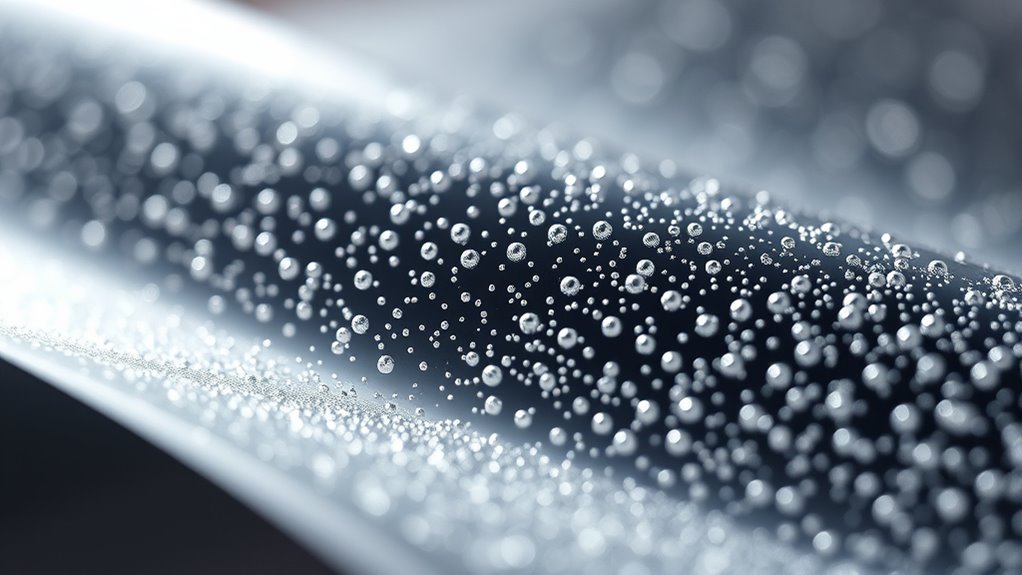
Integrating nanoparticles into thermal conductive adhesives offers several key advantages that enhance their performance. First, they improve thermal conductivity, allowing heat to transfer more efficiently and effectively. This means you can often use less adhesive material, leading to cost reduction without sacrificing performance. Additionally, nanoparticles enable formulations that require lower filler content, which can reduce material costs and simplify manufacturing processes. From an environmental perspective, using fewer materials and achieving higher efficiency helps lower the environmental impact of production and disposal. Nanoparticles also promote better dispersion within the adhesive, resulting in more uniform properties and increased reliability. Moreover, research indicates that the use of nanoparticles can influence brainwave patterns, potentially leading to innovative approaches in material science. Overall, incorporating nanoparticles makes thermal adhesives more cost-effective, environmentally friendly, and better suited for high-performance applications.
Manufacturing Processes and Formulation Techniques
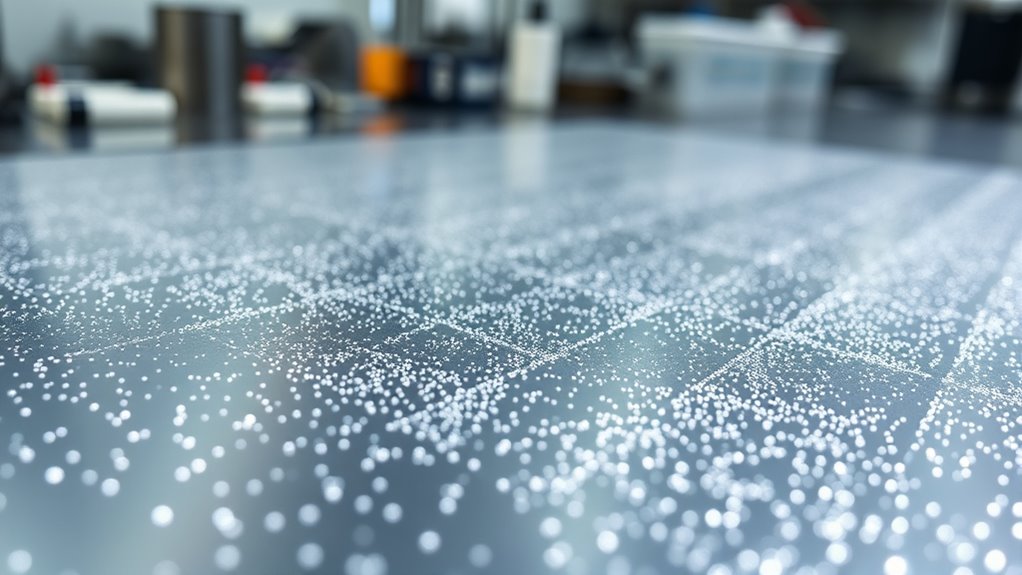
To harness the full benefits of nanoparticle-enhanced thermal conductive adhesives, precise manufacturing processes and formulation techniques are essential. You should carefully select solvents that guarantee proper dispersion of nanoparticles without compromising the adhesive’s integrity. Solvent selection impacts viscosity, stability, and ease of application. Mixing techniques are equally critical; employing high-shear mixing or ultrasonication can effectively break up agglomerates and uniformly distribute nanoparticles within the binder. Consistent mixing speed and duration prevent uneven dispersion, which could reduce thermal performance. Additionally, controlling temperature during mixing helps maintain ideal viscosity and prevents premature curing. By refining these processes, you ensure a homogeneous formulation that maximizes thermal conductivity while maintaining strong adhesion properties. Proper dispersion techniques and process control are crucial for achieving optimal results. This meticulous approach is crucial for developing reliable, high-performance nanoparticle-based adhesives.
Performance Metrics and Thermal Conductivity Enhancement
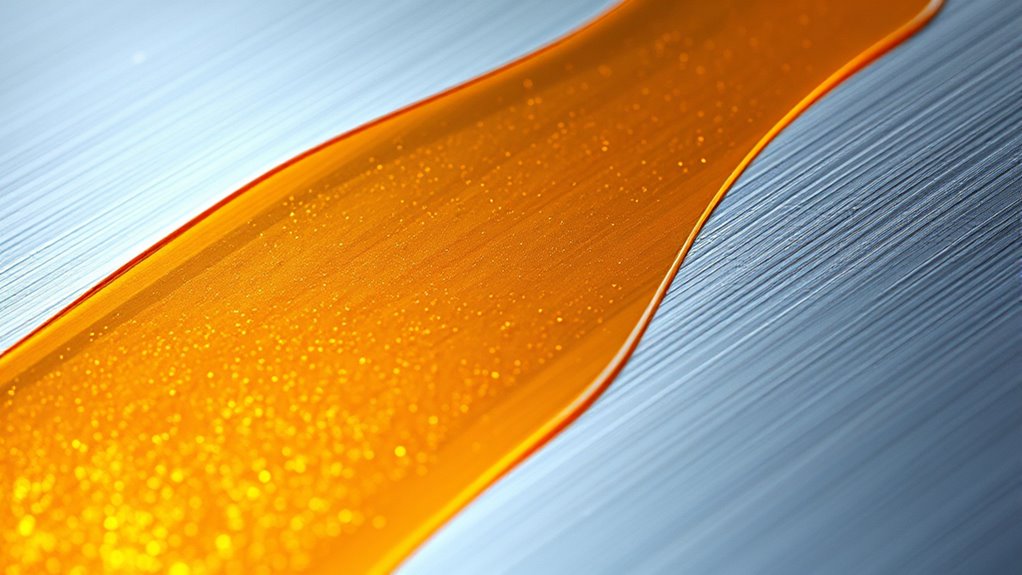
Improving the performance of nanoparticle-based thermal conductive adhesives hinges on accurately measuring their key metrics and effectively enhancing thermal conductivity. You need to assess thermal conductivity to guarantee efficient heat transfer, but also monitor thermal stability to prevent degradation under operating conditions. Electrical insulation is vital, especially when adhesives are used near sensitive electronics; maintaining high electrical resistance while boosting thermal performance is a delicate balance. Enhancing thermal conductivity often involves optimizing nanoparticle loading, dispersion, and morphology, which directly impact both thermal stability and electrical insulation. You can achieve better results by selecting suitable nanoparticles and formulation strategies that maximize heat transfer without compromising insulation or stability. Precise evaluation of these metrics guides improvements, ensuring the adhesive performs reliably in demanding environments. Additionally, understanding the AI security landscape helps develop safer and more trustworthy materials by anticipating potential vulnerabilities and ensuring robust safety measures.
Applications in Electronics and Industry
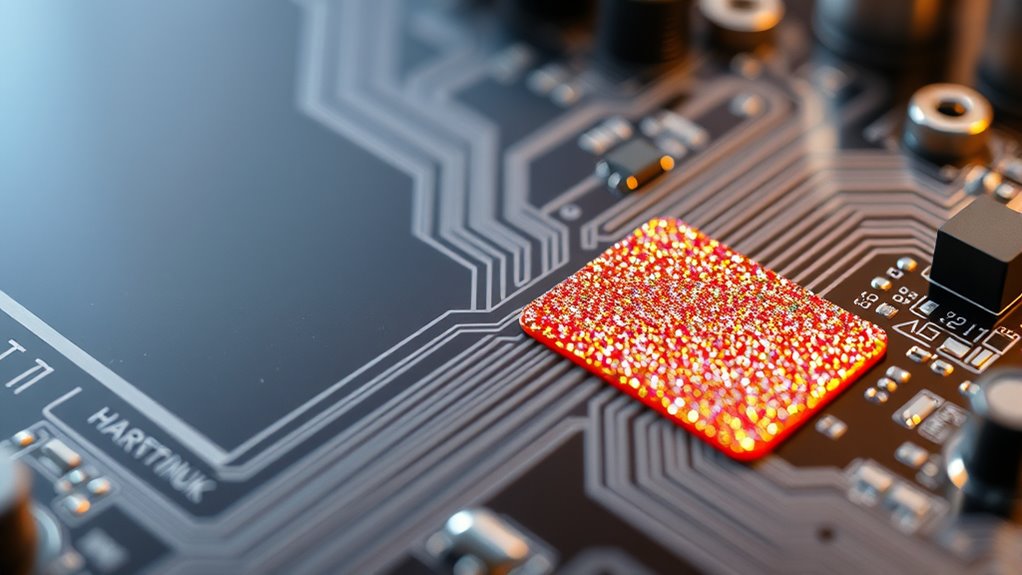
Nanoparticle-based adhesives improve heat dissipation in electronic devices, helping them run cooler and more reliably. They also enable lighter, more compact device designs by reducing weight without sacrificing performance. In industry, these adhesives streamline manufacturing processes, boosting efficiency and product quality. Additionally, paint sprayer technology advancements demonstrate the importance of high-performance tools in achieving optimal application results.
Enhanced Heat Dissipation
Enhanced heat dissipation plays a essential role in ensuring the reliability and performance of electronic devices and industrial equipment. Nanoparticle surface modification improves the thermal properties of thermal interface materials (TIMs) by increasing their compatibility and bonding with substrates. This modification enhances the dispersion and stability of nanoparticles within the adhesive, leading to better heat transfer pathways. Using nanoparticle-based thermal adhesives, you can markedly reduce thermal resistance, allowing heat to flow more efficiently away from critical components. This results in lower operating temperatures, improved device longevity, and increased performance. By optimizing nanoparticle surface chemistry, you enable adhesives to serve as highly effective thermal conductors, making them ideal for applications where efficient heat dissipation is essential.
Lightweight Device Integration
In modern electronics and industrial systems, reducing device weight is crucial for enhancing portability, efficiency, and ease of installation. Lightweight device integration benefits from nanoparticle-based adhesives that maintain high thermal conductivity without adding bulk. Quantum effects become significant as nanoparticles shrink, improving heat transfer at interfaces while keeping the overall weight minimal. However, nanoparticle toxicity remains a concern; selecting biocompatible or environmentally safe materials is essential to prevent health risks during manufacturing and usage. These adhesives enable thinner, lighter designs, simplifying assembly and reducing device fatigue. By leveraging nanoparticle properties, you can achieve durable, thermally efficient connections that support compact, portable electronics and industrial equipment, all while addressing safety considerations and maintaining performance standards.
Industry Manufacturing Efficiency
Implementing nanoparticle-based thermal adhesives substantially boosts manufacturing efficiency in electronics and industrial sectors. Their superior thermal conductivity accelerates assembly processes by reducing curing times and improving joint reliability. As market penetration increases, these adhesives enable faster production cycles and lower defect rates, enhancing overall productivity. Additionally, they help minimize equipment downtime due to better heat management, leading to cost savings. From an environmental perspective, nanoparticle adhesives often require less material and energy, decreasing their environmental impact. Their durability reduces the need for rework and replacements, promoting sustainable manufacturing practices. By streamlining thermal management and lowering resource consumption, nanoparticle-based adhesives support industries in achieving higher efficiency, faster throughput, and more eco-friendly operations, making them a crucial advancement in modern manufacturing.
Challenges and Limitations

Despite the promising potential of nanoparticle-based thermal conductive adhesives, several challenges limit their widespread adoption. Scalability issues pose a significant hurdle, as producing consistent, high-quality nanoparticles at an industrial scale remains complex and costly. This can hinder mass manufacturing and increase overall costs. Environmental concerns also raise red flags, since nanoparticle synthesis often involves hazardous chemicals and energy-intensive processes that may harm ecosystems and human health. Additionally, integrating nanoparticles uniformly within adhesives can be difficult, leading to inconsistent thermal performance. These limitations mean that, despite their advantages, these adhesives are not yet ready for broad commercial use. Overcoming scalability challenges and addressing environmental impacts are essential steps toward making nanoparticle-based adhesives a viable, sustainable solution. Moreover, ongoing research into nanoparticle synthesis techniques aims to mitigate some of these issues and promote wider adoption in the future.
Future Trends and Developments
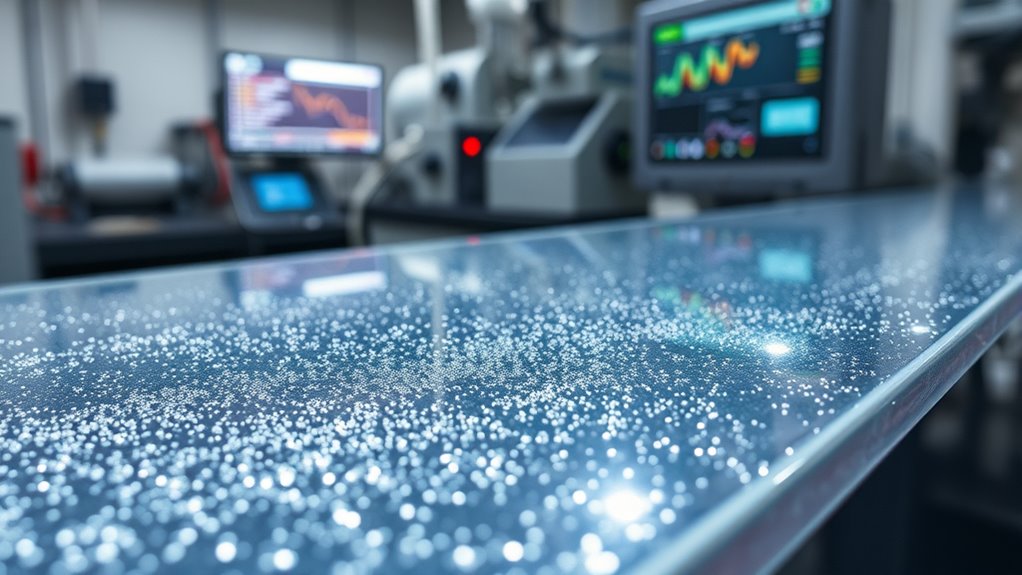
Advancements in nanomaterials and manufacturing techniques are driving promising developments in nanoparticle-based thermal conductive adhesives. You can expect future innovations to leverage quantum effects, enhancing thermal performance at the nanoscale. Researchers are exploring how quantum confinement and tunneling influence heat transfer, potentially leading to adhesives with superior conductivity. Additionally, there’s a strong focus on environmental sustainability, with efforts to develop eco-friendly nanoparticles and biodegradable binders. These trends aim to reduce toxic waste and energy consumption during production. As these technologies mature, you’ll see adhesives that are not only more efficient but also greener. The integration of quantum effects and sustainable practices will shape the next generation of thermal adhesives, aligning performance with ecological responsibility. AI security technologies are also being considered to monitor and optimize manufacturing processes for improved safety and efficiency.
Frequently Asked Questions
How Do Nanoparticle Sizes Influence Adhesive Curing Times?
Smaller nanoparticles improve adhesive curing times by enhancing nanoparticle dispersion and accelerating curing kinetics. Their high surface area promotes better interaction with the adhesive matrix, leading to quicker heat transfer and polymerization. You’ll notice that reducing nanoparticle size results in more uniform dispersion, which speeds up curing. As a result, selecting appropriately sized nanoparticles optimizes the curing process, ensuring efficient adhesion and thermal conductivity for your application.
What Environmental Impacts Are Associated With Nanoparticle-Based Adhesives?
Have you considered the environmental impacts of nanoparticle-based adhesives? These materials can pose risks like environmental toxicity if not properly managed. Waste management becomes vital, as disposal might release harmful nanoparticles into ecosystems, affecting wildlife and human health. Are we prepared to handle these potential dangers responsibly? It’s imperative to develop safer disposal methods and regulations to minimize environmental harm and guarantee sustainable use of nanotechnology.
Are There Any Health Risks During the Manufacturing Process?
During manufacturing, you face health safety risks from exposure to nanoparticles, which can be inhaled or contact skin, potentially causing respiratory issues or skin irritation. Manufacturing emissions may release harmful particles or fumes, increasing risks for workers. It is crucial to implement proper safety measures, like protective gear and ventilation systems, to minimize health risks. Staying aware of safety protocols helps protect your health during the production process.
How Do Cost Factors Compare to Traditional Thermal Adhesives?
You’ll find that nanoparticle-based thermal conductive adhesives typically have higher material expenses compared to traditional adhesives, mainly due to the cost of nanoparticles. The cost comparison shows that initial prices are elevated, but you might save money long-term through better thermal performance and reduced cooling requirements. While material expenses are higher upfront, the improved efficiency can offset costs over the device’s lifespan, making them a viable choice for high-performance applications.
Can These Adhesives Be Recycled or Reused Effectively?
You might wonder if nanoparticle-based thermal conductive adhesives can be recycled or reused effectively. Currently, recycling challenges limit their reuse potential due to the difficulty in separating nanoparticles from the adhesive matrix. While some advancements aim to improve recyclability, most of these adhesives are designed for single use. Consequently, their reuse potential remains limited, and you should consider proper disposal methods to minimize environmental impact.
Conclusion
By harnessing nanoparticles, you can revolutionize thermal conductive adhesives, turning ordinary materials into extraordinary heat conductors. As you explore their advantages, challenges, and future possibilities, remember that innovation fuels progress. With each breakthrough, you’re not just enhancing performance—you’re shaping a smarter, more efficient industry. Embrace this journey, where science meets ingenuity, and watch how tiny particles spark giant leaps forward in electronics and beyond. The future of thermal management is in your hands.


